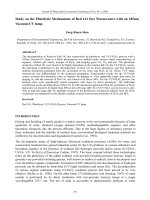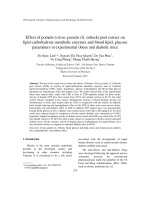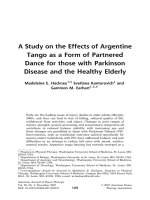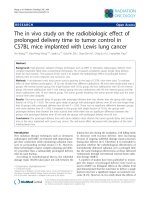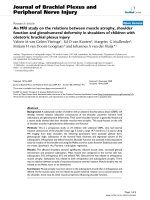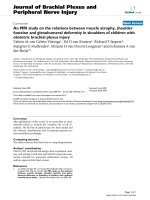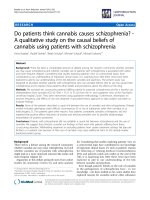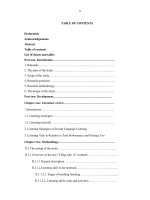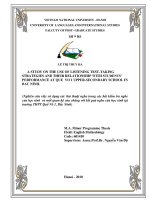Study on the production of coffee with the supplement of tangerine (citrus reticulata l var ) peel
Bạn đang xem bản rút gọn của tài liệu. Xem và tải ngay bản đầy đủ của tài liệu tại đây (4.07 MB, 73 trang )
MINISTRY OF EDUCATION AND TRAINING
HO CHI MINH CITY UNIVERSITY OF TECHNOLOGY AND EDUCATION
FACULTY FOR HIGH QUALITY TRAINING
CAPSTONE PROJECT
FOOD TECHNOLOGY
STUDY ON THE PRODUCTION OF COFFEE
WITH THE SUPPLEMENT OF TANGERINE
(Citrus reticulata L. var.) PEEL
LECTURER: M.Eng. NGUYEN QUANG DUY
STUDENT: CHU TAN DAT
BUI MINH DANG
SKL 0 0 8 4 4 6
Ho Chi Minh City, December, 2021
HO CHI MINH CITY UNIVERSITY OF TECHNOLOGY AND EDUCATION
FACULTY OF HIGH QUALITY TRAINING
GRADUATE PROJECT
CODE: 2021-17116008
STUDY ON THE PRODUCTION OF COFFEE WITH
THE SUPPLEMENT OF TANGERINE (Citrus reticulata L.
var.) PEEL
CHU TAN DAT
Student ID: 17116008
BUI MINH DANG
Student ID: 17116009
Major: FOOD TECHNOLOGY
Advisor: NGUYEN QUANG DUY, M.Eng.
Ho Chi Minh City, December 23th 2021
ii
GRADUATION PROJECT ASSIGNMENT
iii
ACKNOWLEDGEMENTS
During the implementation of graduation project "Study on the production of coffee
with the supplement of tangerine (Citrus reticulata L. var.) peel.". We would like to
express our heartfelt gratitude to the lecturers of Faculty of Chemical and Food Technology
of HCMC University of Technology and Education has created favorable conditions in
terms of facilities, equipment and laboratories so that we can study and conduct
experiments. Moreover, we are extremely grateful for thefor imparting and teaching us a
lot of foundational knowledge during the past 4 years of school who have diligently guided
us in the past.
In particular, we would like to express our heartfelt appreciation to Mr. Nguyen
Quang Duy who is enthusiastically guided us through the completion of this graduation
project. We would also like to thank the family for providing the best conditions, as well
as the greatest and strongest encouragement, to assist us in overcoming academic problems.
The project can not avoid mistakes due to a lack of knowledge and time. We look
forward to receiving your comments and evaluations that our thesis can be improved.
Sincerely thanks !
iv
COMMITMENT
v
ADVISOR’S EVALUATION SHEET
vi
PRE-DEFENSE EVALUATION SHEET
vii
viii
EVALUATION SHEET OF DEFENSE
COMMITTEE MEMBER
ix
x
xi
xii
xiii
xiv
xv
xvi
xvii
xviii
xix
xx
TABLE OF CONTENTS
GRADUATION PROJECT ASSIGNMENT .................................................................iii
ACKNOWLEDGEMENTS ............................................................................................. iv
COMMITMENT ............................................................................................................... v
ADVISOR’S EVALUATION SHEET ............................................................................ vi
PRE-DEFENSE EVALUATION SHEET ..................................................................... vii
EVALUATION SHEET OF DEFENSE COMMITTEE MEMBER .......................... ix
LIST OF FIGURES ......................................................................................................xxiii
LIST OF TABLES ........................................................................................................ xxiv
ABSTRACT ................................................................................................................... xxv
CHAPTER 1: INTRODUCTION .................................................................................... 1
1.1. The project's criticality .............................................................................................. 1
1.2. Aim of the study ........................................................................................................ 1
1.3. Research content ....................................................................................................... 1
CHAPTER 2: OVERVIEW.............................................................................................. 2
2.1. Coffee ........................................................................................................................ 2
2.1.1 Overview about coffee ......................................................................................... 2
2.1.1.1. Classification of coffee .................................................................................... 2
2.1.1.2. Structure and chemical composition ................................................................ 3
2.1.2. Sensory and physicochemical criteria of coffee ................................................. 5
2.2. Tangerine peel ......................................................................................................... 10
2.2.1. Overview about tangerine peel ......................................................................... 10
2.2.2. Chemical composition of tangerine peel .......................................................... 11
2.2.2.1. Limonene ....................................................................................................... 12
CHAPTER 3: MATERIALS AND METHOD ............................................................. 13
3.1. Materials .................................................................................................................. 13
3.1.1. Green bean coffee ............................................................................................. 13
3.1.2. Tangerine peels ................................................................................................. 13
3.1.3. Chemicals.......................................................................................................... 13
3.1.3.2. Chemicals for determined the scavenging activity (DPPH) .......................... 13
3.1.3.3. Chemicals for determined the acidity ............................................................ 14
xxi
3.1.3.4. Tangerine coffee methanolic extract for determined the Total Phenolic
Content and Scavenging Activity (DPPH) ................................................................. 14
3.1.4. Equipments ....................................................................................................... 14
3.2. Process..................................................................................................................... 15
3.2.1. Process proposal of tangerine coffee ................................................................ 15
3.2.2. Describe the process: ........................................................................................ 16
3.3. Analytical method ................................................................................................... 18
3.3.1. Identify Chemical Composition ........................................................................ 18
3.3.2. Determination of Total Phenolic content .......................................................... 18
3.3.3. Determination of Antioxidant activities ........................................................... 19
3.3.4. Titratable Acidity .............................................................................................. 19
3.3.5. Sensory Evaluation Technique ......................................................................... 20
3.3.5.1. Scoring Test (TCVN 3215 – 79) ................................................................... 20
3.3.5.2. Discrimination Tests (Duo-Trio Test) ........................................................... 23
CHAPTER 4: RESULT AND DISCUSSION ............................................................... 25
4.1. Effect of mixing concentration and roasting time on total phenolic content of
tangerine coffee .............................................................................................................. 25
4.2. Effect of mixing concentration and roasting time on antioxidant activities ........... 27
4.3. Effect of mixing concentration and roasting time on titratable Acidity ................. 28
4.4. Sensory Evaluation Technique ................................................................................ 29
4.4.1. Score Test ......................................................................................................... 29
4.4.2. Discrimination Tests (Duo-Trio Test) .............................................................. 30
CHAPTER 5: CONCLUSION AND RECOMMENDATION .................................... 31
5.1. Conclusion............................................................................................................... 31
5.2. Recommendation..................................................................................................... 31
REFERENCES ................................................................................................................ 32
APPENDIX....................................................................................................................... 35
A: ANOVA analyze and Results of Total Phenolic Content ......................................... 35
B: ANOVA analyze of Antioxidant activities ............................................................... 37
C: Results and Anova analyze of Sensory Evaluation ................................................... 38
D: Properties of our group's tangerine peel coffee......................................................... 46
xxii
LIST OF FIGURES
Figure 2.1. Coffee Fruit & Seed Anatomy .......................................................................... 4
Figure 2.2. Typical coffee roasting operation ..................................................................... 7
Figure 2.3. The growth of a coffee bean throughout the roasting process. ......................... 8
Figure 2.4. Tangerine peel ................................................................................................. 11
Figure 3.1. Tangerine Peels ............................................................................................... 13
Figure 3.2. Process of tangerine coffee product ................................................................ 15
Figure 3.3. Experimental layout diagram .......................................................................... 17
Figure 3.4. Samples for sensory evaluation (Scoring Test) .............................................. 22
Figure 3.5. Samples for sensory evaluation (Discrimination Tests) ................................. 24
Figure 4.1. Total Phenolic content of Tangerine coffee samples ...................................... 26
Figure 4.2. The free-radical scavenging capacity (RSC) of the samples by DPPH assay 27
Figure 4.3. The acidity content of the samples .................................................................. 28
xxiii
LIST OF TABLES
Table 2.1. A summary of compositional data (%db) for Arabica coffee beans and Robusta
coffee beans (Clarke, 2012) ................................................................................................. 4
Table 2.2. Requirements for sensory of ground coffee (TCVN 5251:2015) ...................... 5
Table 2.3. Physicochemical requirements for ground coffee (TCVN 5251:2015) ............. 6
Table 2.4. Overview of Agtron roasting stages relating to temperature and color ............. 8
Table 2.5. Chemical composition of tangerine peel essential oil ...................................... 11
Table 3.1. Survey the concentration and roasting time of tangerine peels ........................ 16
Table 3.2. Concentration of sample for determination the total phenolic content ............ 19
Table 3.3. Sensory evaluation scale according to TCVN 3215 – 79 ................................ 20
Table 3.4. Sensory evaluation of tangerine coffee products according to scoring method
TCVN 3215-79 .................................................................................................................. 21
Table 3.5. Quality levels .................................................................................................... 23
Table 3.6. Serving samples of Tangerine Coffee .............................................................. 23
Table 4.1. The score without importance coefficient of 2 samples ................................... 29
Table 4.2. Product quality rating table .............................................................................. 30
Table 4.3. Results of the Duo-Trio Test based on 20 Panelists......................................... 30
xxiv
ABSTRACT
Currently, coffee grown in Vietnam has a low economic efficiency, so product
diversification is required. Simultaneously, application of tangerine waste into other
products increased people's income and reduce the environment pollution. That is the
group's intention when implementing the topic "Study on the production of coffee with
the supplement of tangerine (Citrus reticulata L. var.) peel". Our country's essential oilcontaining plants are diverse and abundant, serving many aspects of life as well as research.
Many fruits and seeds contain high levels of essential oils, with citrus fruits such as
tangerines, oranges, lemons, kumquats, and so on having a relatively higher essential oil
content than other types (primarily in the peel). The following main experiments focus on
developing new products and protecting essential oil content when roasting with coffee:
Investigate the influence of tangerine peel content and roasting time with coffee. The
content of tangerine peel is added about 8% at the roasting time with coffee of 2 minutes;
at this parameter, the antioxidant capacity as well as the total polyphenol content is highest.
The citrus peel coffee product has good parameters after conducting descriptive sensory
analysis and comparing it to regular roasted coffee.
xxv
